The City’s new strategy for revitalizing the Tenderloin, Central Market, and Sixth Street focuses on a set of place-specific ‘Game Changers’ within nine ‘Action Zones,’ along with a number of neighborhood-wide objectives and public realm improvements, intended to build “a healthy and inclusive neighborhood that supports longtime residents, small businesses, nonprofits and arts organizations.”
The nines zones:
- Zone A (Eddy and Leavenworth)
- Zone B (Eddy and Jones)
- Zone C (Golden Gate and Leavenworth)
- Zone D (Turk and Taylor)
- Zone E (Market between 5th and 7th)
- Zone G (UN Plaza and Civic Center Plaza)
- Zone G (Sixth Street)
- Zone H (Larkin Street)
- Zone I (Market and Van Ness)
The Game Changers:
And the link to the City’s detailed Central Market/Tenderloin Strategy document, which includes the neighborhood-wide objectives, public realm projects and proposed implementation plan as well.

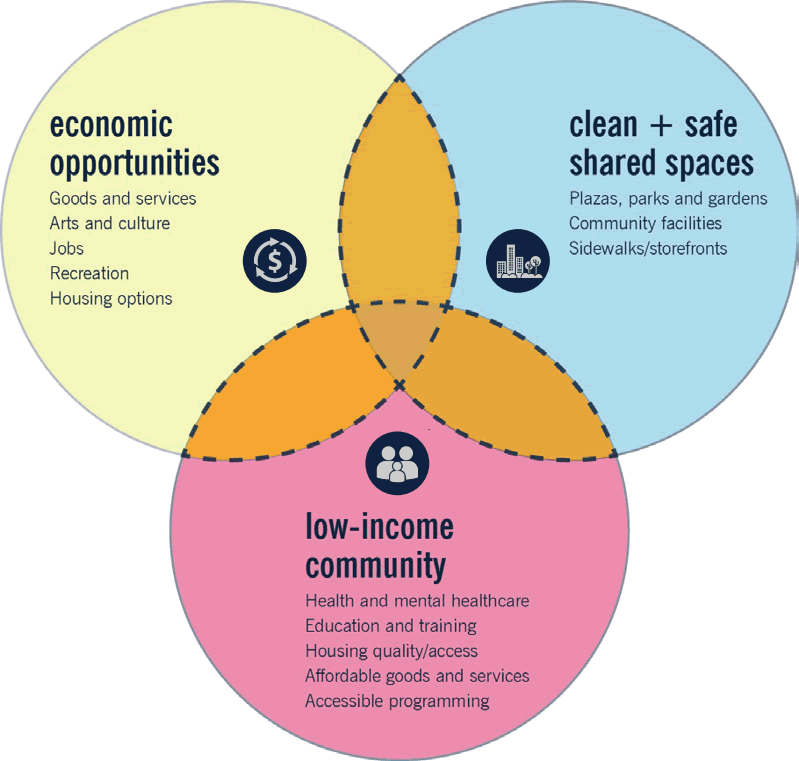
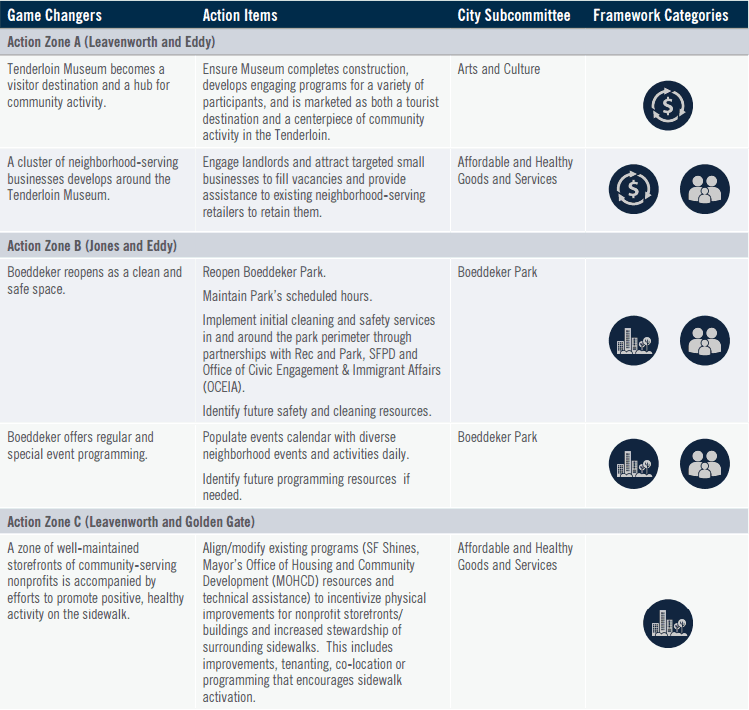
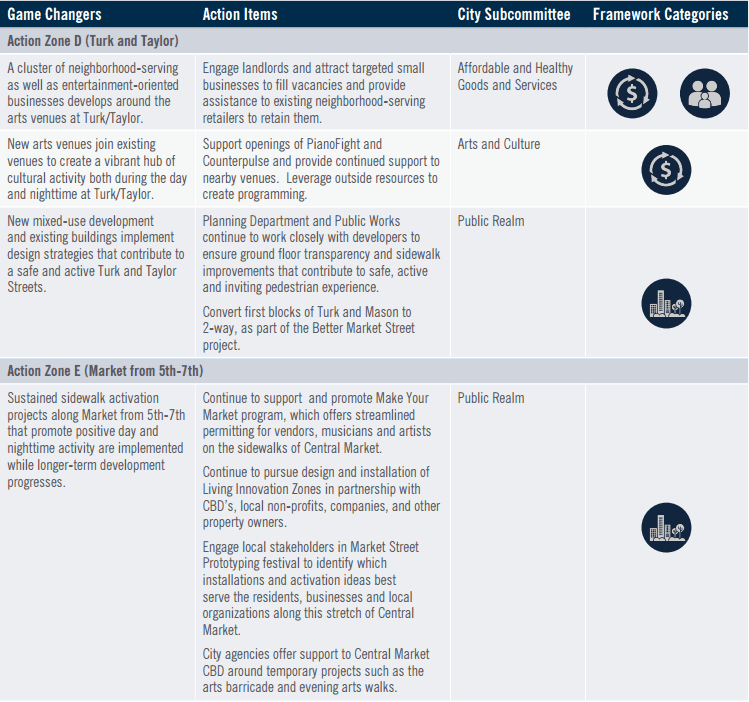
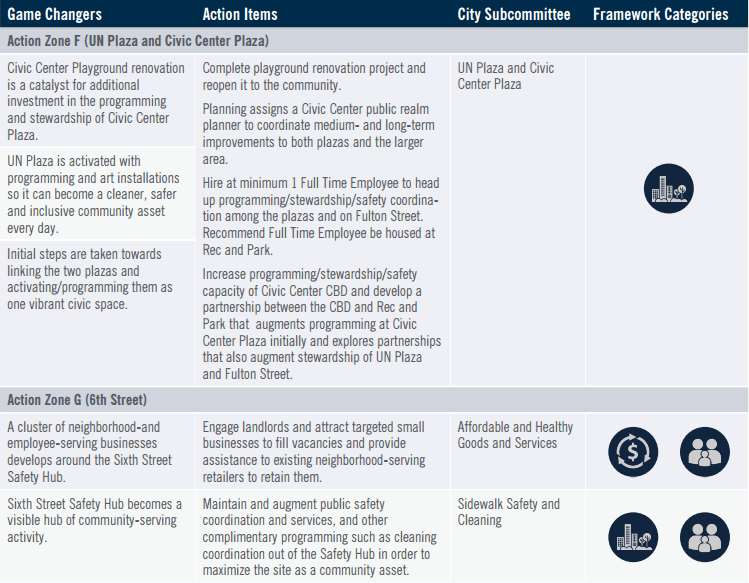
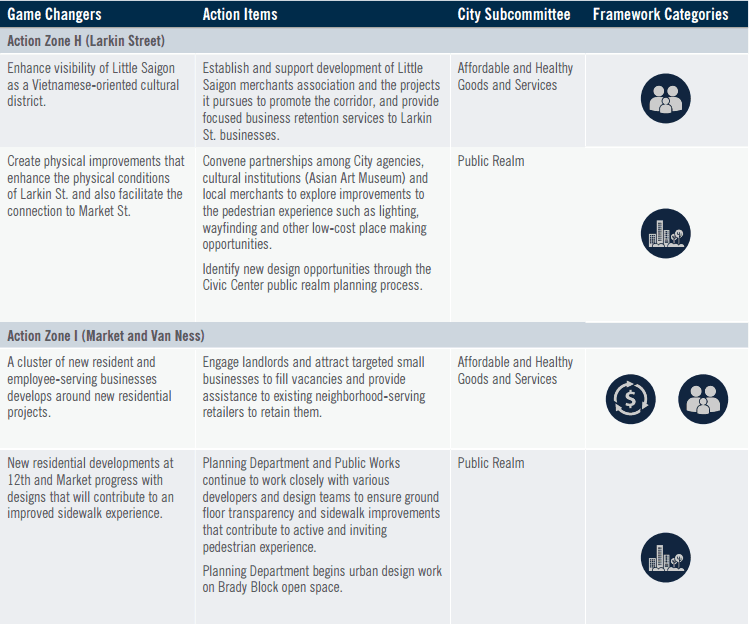
What a load of feel-good grad-school charrette nonsense.
And the few efforts at specifics are even worse – the action items for UN and Civic Center plaza are essentially (i) re-open the playground, and (ii) add more programming activities. Which of those is going to tackle removing human excrement, restoring broken infrastructure, and making the place safe and attractive at night (or heck, even in the day).
Many of the other action items are “open neighborhood-serving businesses”. Uh, OK – setting aside what that even means (for many of the people I see on the street, a corner liquor store would be a “neighborhood-serving business”, how exactly does a feel-good strategy committee go about getting storefronts open? ‘Cause believe me, most landlords are actually quite eager to have tenants, so if a storefront’s empty, there’s probably a good reason.
I’m just disgusted at the tax dollars wasted on things like this. Meanwhile, real progress funded by the private sector is opposed left (Mission District) and right (Warriors Arean), while public services continue to fall apart (any guesses on the date of the next BART rail break?).
What, you want something sensible like greater police presence and real enforcement of quality of life laws?
Yes, ands while we’re at it, clean out the prostitutes and their johns, push out the drug dealers, inject major police presence, get rid of the “massage” parlors, move the homeless to Texas.
Oh, and build market rate housing. Maybe even move the Elbo Room into one of the new ground floor retail spaces. Import the hipsters every evening and let them infest it.
That should work.
You aren’t respecting our history as a port city. Prostitution should be protected by the Historical Society.
You’re right. I did forget that. We don’t want to ever offend any one segment of society when it comes to cleaning up our city. We must allow all to live here, whatever their crime.
And we should provide them housing…and parklets…and uber.
To keep with the sailor tradition, maybe we could Shanghai the homeless?
Shanghai? As in lure them with promises of cigarette trees and streams of whiskey flowing from the Big Rock Candy Mountain? Then they wake up hung over in a sweatshop in remote Asia ready to start a 14 hour shift of assembling Tim Lincecum bobblehead dolls? This sounds like a good black comedy in the making.
Get a full service grocery store in there.
The Historical Preservation Society is literally blocking a lot of these goals from happening. The City claims they want “small businesses to fill vacancies,” yet Historical is forcing new tenants to maintain or renovate ridiculous old (not even original!) structures and materials that have no significance whatsoever. Just a load of bureaucratic BS
Historical Preservation Society. Really? Specifics please.
I don;t know, the vaunted private sector/free market seems to be causing many of the problems. Nothing more free market than street drug dealing, prostitution, and corner liquor stores. Praise Adam Smith!
At least their customers are buying local.
How appropriate that the overlapping parts of the Venn diagram are urine yellow.
I don’t know… looks more like heroin fueled diarrhea to me, or whatever passes for water in the UN Plaza fountain.
You should drink more fluids
And supporting entire Mexican villages and South American countries!
Enforce all laws now on the books. Clean up trash and tags at least once a day. Wash streets and sidewalks at least once a week. Beef up the Community Ambassadors Program. Zero tolerance for drug dealers and users. Stop drinking on streets. Police passing calls in alleys to prevent camping.
We have unrestrained camping on Linden between Franklin and Gough–with all its attendant waste–and routinely call 311 for “move-alongs”. I’ve been present while an officer interviewed a camper who said he was on probation for a drug arrest, was sleeping off a bad trip, and that his collection of markers was for tagging. He was left in place.
Also, pay for the aforementioned… How?
My Strategy to the City: Leave Private Enterprise Alone. Tackle your own in house problems like graft. The City is really becoming the most worthless mother in law in the world.
And everything Oh Dear said…
interesting: Author Dave Eggers’ nonprofit heading to Tenderloin
“…last week [Tenderloin landlord Paul Boschetti] and 826 Valencia agreed to a 15-year lease [for 172 Golden Gate Ave]. Rent is about 25 percent below market and the first year will be free. It will be the largest of 826 Valencia’s seven locations — a 5,000-square-foot space with windows wrapping around the northeast corner of Leavenworth Street and Golden Gate Avenue.
Bita Nazarian, executive director of 826 Valencia, said the organization has raised $1.8 million for the project and hopes to drum up another $2.2 million. The $4 million will cover capital expenses as well as providing enough money to operate for the first year or two. She hopes to open in January.
She said the center would start with two main programs: the book-making and storytelling program, similar to the one in the Mission District, as well as an after-school education and activities program for middle and high school students, in partnership with groups like Boys and Girls Club and the Tenderloin Neighborhood Development Corp.”
Stop paroling ex-cons to the TL, that’ll go a long way.
Hey! They DESERVE to live in the center of one of the most expensive cities in the world! They EARNED it.
/s
Where is the part about no human poop on the sidewalks?
Do you not appreciate the heart-felt sincerity of this effort?
The bureaucrats who developed this plan really would like the Tenderloin to be a happy and joyful community of poor people. However, they are torn between the goals of safety and cleanliness, and the need to provide a place for drug dealers and prostitutes to live. Chris Daly set out the latter goal, and with all good intentions, they are working to achieve it.
But now and for the future, absent the evil of gentrification, the Tenderloin will remain the most misused piece of central urban real estate in America.
Damn those lower economic class losers getting in the way of the development tide.There’s money to be made building luxury towers there, but these little people, with their “homes” and “community” are blocking progress and profit.
Game changers…hahaha…more like game-the-same’rs!!!
A resounding “yes” to all the comments on here. Nice to finally see everyone on the same page for once, not that a united front will really change anything.
In all seriousness, there are real people with real problems in that area. And if I were convinced that an extra 10% increase in my property taxes could help them, I’d gladly pay. But I’d want two things in return, quality of life improvements (we increase the size of the carrot, we double the size of the stick) and accountability and metrics from the city and the non-profits. This includes greater police presence and enforcement of existing laws.
It must suck to be homeless and aspire to get out of an SRO in the Tenderloin. Having neighbors doing drugs and bedbug and vermin infestations has to make it much harder to get back on one’s feet. Cleaning up isn’t gentrifying things, it’s enforcing minimum standards for the benefit of everyone.
Same, Same, Same
How about we get rid of all the SROs? We all know where the problem is coming from.
Or at a minimum rezone the entire neighborhood and add height and density so enough market-rate developments can come in because maybe the people will actually start demanding the city enforce the laws on the books and keep the streets clean and safe.
I like that. SRO’s are nothing more than drug dens in disguise for criminals.
Wrong. Poor people are not all criminals or addicts, despite what you may think. A lot of hard working poor people (including many immigrants), low-income disabled people, etc, live in SROs.
No one said poor people are all criminals or addicts. The poor are often poor because of stupid choices they make because they are not the sharpest tool in the shed. Having children (and often more than one) when you are already on an extremely tight budget…hence having to scrape by. Not going to vocational school/job training for skilled jobs (during the periods of low or no employment.) Or simply living in another part of the country where there is a shortage of manual labor/minimal services skills ie. Alaska, Wisconsin, the Dakotas. None of these alternatives are available to them if there have a family and a bunch of kids.
they, not there.
A lot of working immigrant poor are in the construction trades, food services, and cleaning services. These skills sets are highly transferrable and sought after in other parts of the country. The pay is probably higher in those areas and housing is cheaper. They can afford kids and have a more stable and easier life where there is less competition. Upward mobility sometimes requires lateral mobility.
Do you use the same broad brush to paint the walls you’ve built as you have to paint the lives of the less fortunate? And do you dip it in the same vat of antipathy?
It’s a cold and it’s a broken Hallelujah.
But many, if not most SRO’s are full of criminals and drug addicts. These are not the same people as just people who are poor. Poor people deserve good, safe, decent housing, and much more than just an SRO to live in.
I suggest a Final Solution, then.
Because you will always have “criminals”* and “drug addicts”. Always have had, always will.
* I would argue petty drug dealers and the like are not the real criminals. Not when the gleaming office towers a few dozen blocks south are full of gambling houses (errr…I mean banks and financial services companies) and companies like BANE Capital. Heck, many of our 1% earn their money, ultimately, by laundering drug profits and funding terrorist gangs. Read about the lovely history of HSBC, the bank that was too big to even charge with any crimes.
So, you Ayn Randsters on here just remember where the real crime is occurring.
Sadly the SRO’s are not going anywhere. They are exempt from Ellis Act, so converting use is nearly impossible unless deep pocket owners can wait it out and the design of many with only shared baths does not lend them to tourist or regular apartment use. Many are funded by tax dollars and subsidies – see Tenderloin Housing Clinic.
Also, SRO owners make a *ton* of money. Think about it. They get to provide crappy buildings with limited upkeep costs and fewer bathrooms than normal, and the city will guarantee them revenue. It’s a great business model.
Care Not Cash remit how much per SRO? 400?
They have fixed costs, utilities, security,…
No they are not getting rich on this. $13/day is making you break even, maybe.
I just noticed their “strategy” for Zone I = Market & Van Ness… calls for more residential development.
Good thing there are *already* multiple 300′-400′ projects in the works there, LOL. I’m sure when those towers are finally built, whoever put together this “strategic plan” will claim that it successfully spurred development!
that’s a lot of lipstick.
Lets say for discussion that these goals are all good and would make a difference if implemented.
Absent private investment or City of SF investment, I do not see how it happens. Museum for example must be $40 MIL bare minimum if you just compare recent institutional development.
The city does not have meaningful $$$ that it would allocate here, and if private investment at this point in the bubble has not yet led to TL area upgrades, i dont know if it ever will. Maybe three more years of bubble will push private $$ to really permeate the TL, assuming it is allowed to do so.
So my question is– much of this stuff sounds great from a policy point of view ( lets just say) but what is the plan for it to ever be implemented?
–New TL bond issue getting city wide 67%?
–New city wide TL property tax?
–BOS allocating say $100 MIL of its slim discretionary budget?
–More developer fee exactions, say $50 PSF for developing anywhere nearby?
–Or paying that fee instead of additional affordable housing?
–Give up something else in the SF budget to allocate here (police, fire, transit, parks, schools, department staffs)
–Rich, benevolent tech companies or owners paying for this?
Nope.
I have lived here for 29 years. This area and these solutions are like groundhog day. We throw money and “pie in the sky” ideas to “clean it up” and nothing changes. New folks move into the city and think these ideas and proposals are new and fresh, only to eventually see that nothing changes. They too will be writing in 30 years that they are tired of the whole issue. We are a delusional city. The fundamental issue is that we, as a city, have built a homeless bureaucracy in the Tenderloin that collaborates with the city to “help” the “homeless”. But in turn, we have absolutely no expectation that the “homeless” should act/behave within the laws of civility. They are victims…we can’t expect anything of them!”I personally would call it enablement. Build it and they will come! Do not fool yourself…none of this will change anything.
Exactly. There are existing laws that could deal with bad actors. But the city/homeless support industry doesn’t have the will do really deal with them. So they do the second best thing and corral them in certain areas. Hamsterdam by the bay. Without changing the underlying issues nothing will change here. Because if they cleaned up the TL where would these people go? They’d spread out to other parts of the city, which is even worse than what you have now.
They should move the homeless to Richmond and Vallejo. When did everyone become so entitled to live in one place?
Get rid of the SRO’s. Let the market, clean up downtown. What would end up happening is these buildings could be gutted and nice condos could be created for hard working tax payers. Make it hard to access the BART and Muni. Essentially, require a smart phone (pretty much everybody has one nowadays)
And then the city will become clean almost instantly!
So turn SF into a gated community for selfish, thin-skinned rich people? Block off public transit because it gets used by scary poor people? LOL yeah, that’s a great idea. And I’m sure Richmond and Vallejo would love to have SF’s homeless people. Oh, and somehow that will make the entire city clean? I think I got brain cancer reading your post.
There’s a whole city bureaucracy who’s employment is predicated on these people being in SF. Plus the whole homeless industry that conducts studies, administers grants and runs programs. That’s that constituency that ensures these folks stay here with us.
But who’s being selfish here? Does it really benefit the homeless/poor to be here in SF or just those that administer/run these programs? There may be a very small fraction of people who are temporary down on their luck and have local connections that would make it easier to get back on their feet locally. But for the harder up cases, wouldn’t aid money go farther in a lower cost of living area? And administrative costs would be much lower as well since the administrators wouldn’t need to be paid SF salaries. And wouldn’t the transition off the dole be much easier in lower cost areas with lower end employment? The days of sobering up and getting a factory job are over. How many can go from the streets to paying SF rent by snagging a job at the Googles and Genetechs of the area?
So.,..fire all the bureaucrats and all of then homeless will magically disappear?
I work in the outer suburbs. We don’t want your problems exported here, either.
Don’t fire them, just transfer them somewhere cheaper.
And I’m still waiting to hear the arguments that it serves the interests of the homeless/poor to be served here rather then some lower cost area.
“Clean and safe” “Clean and safe” Clean and safe”. In order to make any of these areas “clean and safe”, the “longtime residents” have to be removed since they are what has made it unclean and unsafe all along. Not going to happen, though.
Without City maintained public bathrooms these streets will continue to smell of poop and pee.
Other American cities do not smell like poop and pee.
Why is our City government so lazy and incompetent on this one issue?
Possibly because they live in what they feel is a “better district”.
You know, the most effective initiative for revitalizing my neighborhood (Zone G) would be to legalize the harpooning of dumpster divers (aka the night crawlers who turn over garbage bins onto the street on garbage night). I am fairly certain these are the same people who sh!t on the side of my house every week…
Here’s another idea: sprinkle these action zones with bags of tainted crack and let the problem kill itself.
This was good for a laugh. There is a group of people who want to be permanently homeless as a lifestyle choice, and there are also sadly a lot of severely mentally ill people who have no hope of living independently ever.
We can either coddle them and pretend they are both one handout away from turning it around, forever, OR we can do things that make most liberals feel very uncomfortable. Maintaining a large “minimum security jail” (but in reality just a vagrant dormitory) far outside the city where we just lock them all up on the criminal charges we don’t enforce today (say public defecation, public intoxication, illegal camping, aggressive panhandling) would go a long way. I don’t actually mind feeding, clothing, and paying for opiates for them — WE ALREADY DO since 100% of their income is publicly-funded!! But the real insult to taxpayers and working people is that despite paying heavily for them, we also still have to have their presence here, ruining large sections of the city for anyone else’s enjoyment.
wouldn’t aid money go farther in a lower cost of living area? And administrative costs would be much lower as well since the administrators wouldn’t need to be paid salaries. here may be a very small fraction of people who are temporary down on their luck and have local connections that would make it easier to get back on their feet locally. Or at a minimum rezone the entire neighborhood and add height and density so enough market-rate developments can come